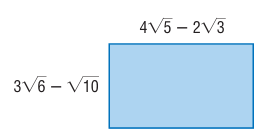SIMPLIFYING RADICAL EXPRESSIONS
Subscribe to our ▶️ YouTube channel 🔴 for the latest videos, updates, and tips.
To simplify radical terms, we have to decompose the term that we have inside the radical as product of prime factors.
Then, we can take one value out of the radical sign for every two same values which are multiplied inside the radical sign.
Add and subtract like radicals :
Multiply radical terms :
Divide radical terms :
Using algebraic identities :
Simplify each expression.
Problem 1 :
√600
Solution :
= √600
= √100 × 6
= √100 × √6
= 10√6
Problem 2 :
√50 + √18
Solution :
= √50 + √18
= √ (25 × 2) + √ (9 × 2)
= 5√2 + 3√2
= 8√2
Problem 3 :
(5√6)²
Solution :
= (5√6)²
= 5² × (√6)²
= 25 × 6
= 150
Problem 4 :
√3(√3 + √6)
Solution :
= √3(√3 + √6)
= (√3 × √3) + (√3 × √6)
= 3 + √18
= 3 + √ (9 × 2)
= 3 + √9 × √2
= 3 + 3√2
Problem 5 :
√19²
Solution :
= √19²
= √19 × 19
= 19
Problem 6 :
√64 + 36
Solution :
= √64 + 36
= √64 + √36
= 8 + 6
= 14
Problem 7 :
√2(√2 + √6)
Solution :
= √2(√2 + √6)
= (√2 × √2) + (√2 × √6)
= 2 + √12
= 2 + √ (4 × 3)
= 2 + √4 × √3
= 2 + 2√3
Problem 8 :
√2(√3 + √8)
Solution :
= √2(√3 + √8)
= (√2 × √3) + (√2 × √8)
= √6 + √16
= √6 + √ (4 × 4)
= √6 + √4 × √4
= √6 + 4
= 4 + √6
Problem 9 :
√36/324
Solution :
= √36/324
= √36/√324
= 6/18
= 1/3
Problem 10 :
√50/√2
Solution :
= √50/√2
= √50/2
= √25
= 5
Problem 11 :
8√25/4
Solution :
= 8√25/4
= 8 (√25/√4)
= 8 × 5/2
= 4 × 5
= 20
Problem 12 :
√16/4
Solution :
= √16/4
= √16/√4
= 4/2
= 2
Problem 13 :
2√2 [3/√2 + √2]
Solution :
= 2√2 [3/√2 + √2]
= 2√2 × [(3√2/√2 × √2) + √2]
= 2√2 (3√2/2 + √2)
= 2√2 [(3√2 + 2√2)/2]
= √2 (3√2 + 2√2)
= √2 × 5√2
= 2 × 5
= 10
Problem 14 :
A rectangle has width 3√5 cm and length 4√10 cm. Find the area of rectangle.
Solution :
Length = 4√10 cm
Width = 3√5 cm
Area of rectangle = length x width
= 4√10(3√5)
= 12√(10 x 5)
= 12√(2 x 5 x 5)
= 12 x 5√2
= 60√2
Problem 15 :
A rectangle has length √(a/8) meters and width √(a/2) m. What is the area of rectangle ?
Solution :
Length = √(a/8) meters
Width = √(a/2) meters
Area of rectangle = length x width
= √(a/8) √(a/2)
= √(a/8)(a/2)
= a√(1/4 x 4)
= a/4 cm2
Problem 16 :
The formula for area A of a square with side length s is A = s2. Solve the equation for s, and find the side length of a square having an area of 72 square inches.
Solution :
Area A = s2
Given that, the area is 72 square inches
72 = s2
s = √72
s = √(2 x 2 x 2 x 3 x 3)
= 2 x 3√2
= 6 √2 inches
Problem 17 :
If x = 81b2 and b > 0, the find √x =
a) -9b b) 9b c) 3b√27 d) 27b√3
Solution :
Given that, x = 81b2
√x = √81b2
√x = √(9 x 9 x b x b)
√x = 9b
So, option b is correct.
Problem 18 :
Find the area of the rectangle in simplest form.

Solution :
Length = 4√5 - 2√3
Width = 3√6 - √10
Area of rectangle = length x width
= (4√5 - 2√3) (3√6 - √10)
= 4√5(3√6) - 4√5(√10) - 2√3(3√6) + 2√(3 x 10)
= 12√30 - 4√(5 x 10) - 6√(3 x 6) + 2√30
= 12√30 - 4√(5 x 5 x 2) - 6√(3 x 3 x 2) + 2√30
= 12√30 + 2√30 - (4x5)√2 - (6 x 3)√2
= 14√30 - 20√2 - 18√2
= (14√30 - 38√2) square units.
Problem 19 :
Find the perimeter and area of square whose sides measure 4 + 3√6 feet.
Solution :
Side length of square = 4 + 3√6 feet.
Perimeter of square = 4(side)
= 4(4 + 3√6)
= 16 + 12√6 feet
Area of square = (4 + 3√6)2
= 42 + 2(4)3√6 + (3√6)2
= 16 + 24√6 + 9(6)
= 16 + 24√6 + 54
= 70 + 24√6 square feet.
Problem 20 :
The voltage V is required for a circuit is given by V = √PR, where P is power in watts and R is the resistance in ohms. How many more volts area needed to light a 100 watt bulb than a 75 watt bulb if the resistance for both is 110 ohms.
Solution :
V = √PR
When P = 100 watt and R = 110 ohms
V = √(100 x 110)
= √11000
= 104.88
V = √PR
When P = 75 watt and R = 110 ohms
V = √(75 x 110)
= √8250
= 90.82
Difference = 104.88 - 90.82
= 14.06 V
Subscribe to our ▶️ YouTube channel 🔴 for the latest videos, updates, and tips.
Recent Articles
-
Finding Range of Values Inequality Problems
May 21, 24 08:51 PM
Finding Range of Values Inequality Problems -
Solving Two Step Inequality Word Problems
May 21, 24 08:51 AM
Solving Two Step Inequality Word Problems -
Exponential Function Context and Data Modeling
May 20, 24 10:45 PM
Exponential Function Context and Data Modeling